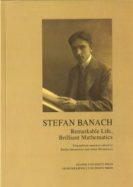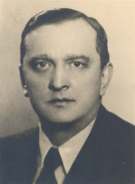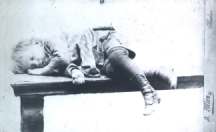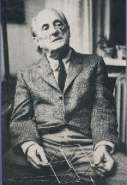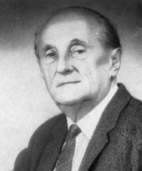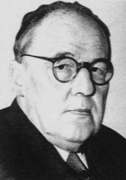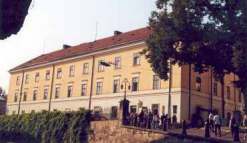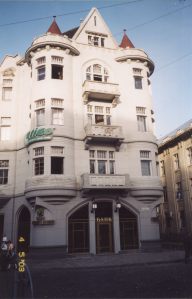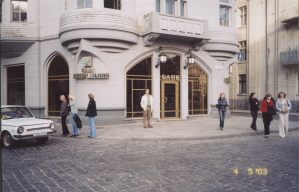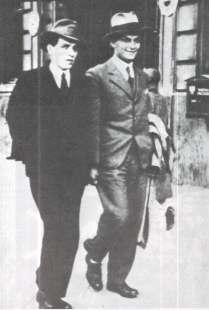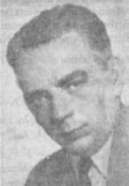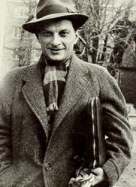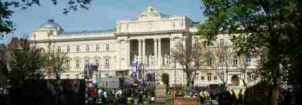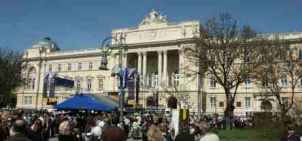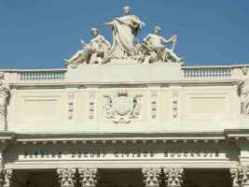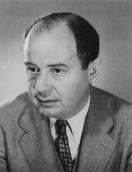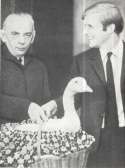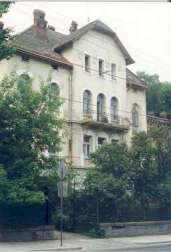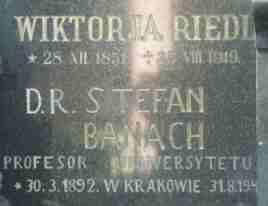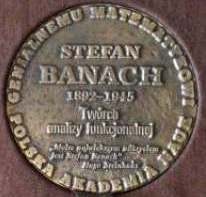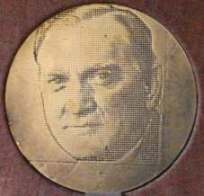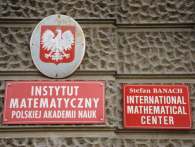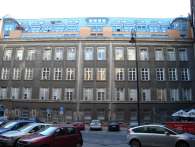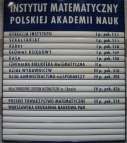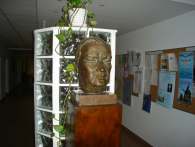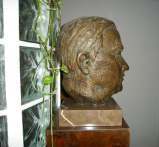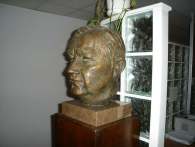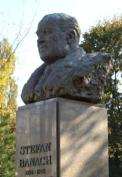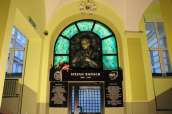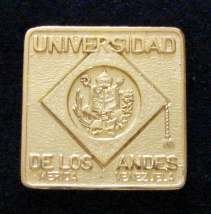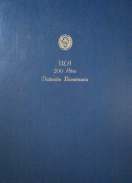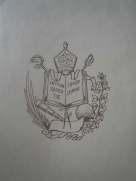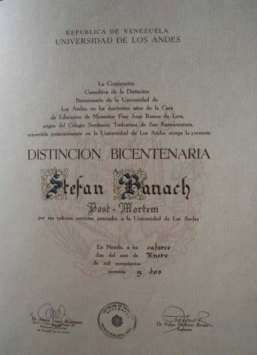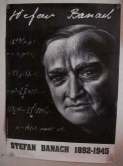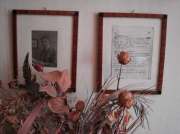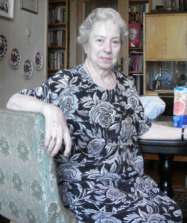Home Page of Stefan Banach
Home Page of Stefan Banach
A Remarkable Life of Stefan Banach
by Emilia Jakimowicz
(translated by John Greczek)
This article was published in Stefan Banach. Remarkable
life, Brilliant mathematics,
ed. by Emilia Jakimowicz and Adam Miranowicz
(Gdańsk University Press, 2011).
1 The Early Years
|
Stefan Banach at 44 years of age, Lvov 1936 |
|
[This photograph is from the private
collection of the Banach family and used here with the
permission of Prof. Alina Filipowicz-Banach.] |
Stefan Banach was born on 30 March 1892, in the St. Lazarus
General Hospital in Krakow. He was the child of Stefan
Greczek and Katarzyna Banach, who were not married. On 3
April 1892, he was baptized in the Roman Catholic Parish of
St. Nicholas in Krakow.
As a month-old baby his parents gave him up to be cared for
in the nearby countryside where he was well looked after, in
exchange for payments by his father. However, after several
months Katarzyna Banach took him away and entrusted him to be
raised by Franciszka Płowa and her niece Maria Puchalska in
Krakow.
|
Stefan Banach at 3 years of age at the Krakow
Planty Gardens. |
|
[Photographed by Juliusz
Mien. This photograph is from the private collection of the
Banach family and used here with the permission of Prof.
Alina Filipowicz-Banach.] |
Stefan Banach thus found himself in the tender care of the
foster family of Franciszka Płowa, the owner of a laundry
business in Krakow, and her niece Maria Puchalska. The
latter's close friend and erstwhile guardian was Juliusz Mien
(1842-1905). He was French but had lived in Poland since 1870
and was a man of letters, translator of Polish literary works
and also a photographer. Mien was in frequent contact with
his good friend Maria, her aunt and their young charge
Stefan, and was the only intellectual in the boy's immediate
milieu. He was, therefore, the most likely person who would
have encouraged and guided his interests in mathematics and
watched over his general education. It was also he who was
undoubtedly responsible for Banach's excellent French that he
later had the opportunity to demonstrate so well at
international mathematics conferences he attended.
It would seem that Banach's conditions were not at all bad
for the times he lived in. Franciszka Płowa's husband was the
director of the Hotel Krakowski and relatively well off.
Banach grew up looking on Franciszka Płowa, the owner of a
successful business, as his natural grandmother and on Maria
as his older sister. Nevertheless, he did not have the best
memories of his childhood. He never knew his mother, although
he did know and had a relatively normal, if not close,
relationship with his father.
While under the care of Franciszka Płowa and her niece Maria,
he began attending school. Not much is known about his early
school days as no documents have so far been found relating
to that time. However, there is considerable material
connected with the time he spent in grammar school and the
years that first shaped his personality and began to reveal
his extraordinary talent and abilities in mathematics. He
completed his primary school education in 1902 and at 10
years of age enrolled in the Henryk Sienkiewicz Grammar
School IV in Krakow. It was located in Podwale Street and was
commonly known by the name of Goetz because it was housed in
a building rented from Jan Goetz-Okocimski, a Krakow brewer.
The school, which emphasized the study of humanities, did not
count as one of the more exclusive. However, it should be
remembered that strong ties existed between the grammar
schools and higher institutions of learning like the
Jagiellonian University and the Polish Academy of Arts and
Sciences. The staff and members of those institutions often
taught at the local schools, thereby raising their academic
standards. This was common practice and the norm at all of
the grammar schools in Krakow.
Two of Banach's schoolmates at that time were Witold Wilkosz
(1891-1941), himself a future mathematician, and Marian
Albiński (1891-1978), who years later wrote his memoirs [1].
It is worthwhile to quote at length from these because they
are the only source to shed light on some characteristics
that Banach exhibited in those early years.
Albiński was a classmate of Banach for four years from 1902
until 1906. He then transferred to the Sobieski Grammar
School for reasons that provide some insight as to the
relations that existed in the schools of that time. According
to Albiński the reason he transferred was due to a conflict
that had arisen between him and a teacher of Greek at the
school who had given him a failing grade at mid-year. In the
school system at the time of the Austro-Hungarian annexation
that was severely punishable by an officially recordable fine
of 20 crowns.
Albiński wrote as follows about Stefan Banach, and about his
best friend Wilkosz [1]:
,,Wilkosz transferred together with me to the Sobieski
Grammar School, for reasons unknown to me. Banach remained in
Grammar School IV until he took and passed his final
examinations there in 1910.
After I left the Goetz school my ties with Banach were not as
strong as before although Wilkosz continued to maintain a
close relationship with him and, as Wilkosz and I were still
friends, I often saw them together.
As I remember him, Stefan Banach was mild mannered but not
without a gentle sense of humor and he was a good friend at
school, although a little reserved. He always wore a clean
and decent school uniform, like the rest of us, and he did
not look pale, sickly, or hungry, although forced through
meager material circumstances to tutor younger schoolmates
for money, as well as those in the wider population; his own
classmates he would help freely and without payment.
From their earliest school years Banach and Wilkosz bonded
together through their mutual love of mathematics. During the
so-called school "breaks" I often saw them solving math
problems, which seemed to me, a student of humanities, to be
quite incomprehensible.
Banach's friendship with Wilkosz was not limited to only the
school grounds. They would meet after class in Wilkosz's home
on Zwierzyniecka Street or in the school buildings as well as
in the Krakow Planty Gardens. Later on, when they were older,
walking home with them through the streets of Krakow might
take half the night when in a very excited state and
oblivious to time they would be discussing some question or
other that challenged their minds.
I took no part in these math discussions but often argued
some other issues at length with Wilkosz, with whom I had a
closer relationship. We were drawn together during our time
at school, and even later, by a common interest in literature
and a penchant for some of the same girls at the school."
After completing grammar school Wilkosz graduated with a
degree in mathematics from the Jagiellonian University in
Krakow where he was later to be appointed a professor.
Roman Kałuża in an extensive biography [2] of Stefan Banach
wrote:
,,There is documentary evidence that Banach was a very
diligent student, which is an uncommon characteristic of
geniuses. And it should be remembered that the school
curricula of that time stressed Latin, Greek and modern
languages, and put little importance on the exact sciences.
Banach attended school when it taught precisely in such a
classical tradition. Consequently, its teaching programme
coincided little with Banach's abilities or interests. Those
teaching mathematics were not always fully competent in that
discipline and Banach in his reminiscences was quite critical
of the lowly level and manner in which his favorite subject
was taught at school.
A large number of documents have survived relating to
Banach's second year at Grammar School IV. It is interesting
to look at the syllabus for that year, and perhaps even
useful to those involved with school reform:
Religion, 2 hours per week. The Old Testament.
Latin, 8 hours per week. Supplementing the knowledge acquired
in the first year about regular forms and indeclinable parts
of speech. The most important irregular forms. Syntax of
common subordinate clauses. Verbal and memory exercises as
during the first year. Every month 3 classroom assignments, 1
home assignment.
Polish, 3 hours per week. Grammar: Review of subjects covered
during the first year. Complex sentences, types of
subordinate clauses. Further study of punctuation and correct
spelling. Reading of abstracts from literature and
recitation. Essays 3 times per month alternating between
home and classroom.
German, 5 hours per week. Speech in the form of questions and
answers to read passages, memorizing words, phrases and whole
passages. Review of regular declension and the main
principles of syntax. A weekly assignment, including one per
month as homework.
History and Geography, 4 hours per week. Ancient history
especially of Greece and Rome employing a biographical
approach. Geographical and political maps of Asia and Africa.
Latitudinal and longitudinal divisions of Europe. Detailed
geography of South Europe and of Great Britain. Cartographic
drawing exercises.
Mathematics, 3 hours per week. Review and further study of
highest common divisor and least common multiple. Systematic
study of common fractions. Conversion of common fractions
into decimals and vice versa. Ratios, proportions. The rule
of three and use of simple proportions. Inference.
Calculation of percentage.
Geometry: Axial and central symmetry, congruent triangles and
their application. The most important properties of circles,
quadrilaterals and polygon. Training and work assignments as
in the first year.
Natural History, 2 hours per week. During the first 6 months
zoology: birds, reptiles, amphibians, fish, crustaceans and
worms, mollusks, protozoa. Starting in March the world of
plants.
The school also offered a choice of other subjects that were
not compulsory: history of the homeland, French (which
according to school records no second year student selected),
singing, art, calligraphy, gymnastics and stenography."
Many years later Banach said that his interest in mathematics
was ultimately aroused and guided by Dr Kamil Kraft (who
taught mathematics and physics at Grammar School IV).
Perhaps through overwork, or boredom with the classroom
material, he lost his enthusiasm for studying. And in 1910,
just before his final graduation exams, he confronted a major
difficulty. He, the excellent student of former years, was
now threatened with a failing grade in eight subjects! Not
even the despairing math teacher may have been able to help
get him through the exams (even after explaining to the high
supervisory commission that they were dealing with an
authentic genius in mathematics) were it not for the
intervention of the school priest, Father Paweł Pyłko, who in
those times would have had a deciding voice. The priest, it
must be said, showed surprising tolerance in supporting the
future mathematician. Banach was a skeptic and had often
embarrassed the good priest with some of his comments.
Out of a total of 27 final year students 6 achieved a passing
grade "with honors". Banach was not among them and had to
be satisfied with a grade "with merit" (behind him were
only two students who had to retake the exams).
After graduation when discussing their future plans Banach
and Wilkosz were both convinced that mathematics was already
so advanced that nothing new could be achieved in it; and so
it would not be worthwhile to go on to study mathematics.
Banach chose technology, and Wilkosz oriental languages. Much
later, when already deeply involved with mathematics, Banach
admitted in a conversation with Prof. Andrzej Turowicz that
in their youthful presumption both Wilkosz and he had been
wrong about the possibility of advances in mathematics [3].
In 1910, the two friends parted company after they graduated
from the grammar school.
2 First Great Adventure with Mathematics
Not much is known about Banach's life during the years
immediately after grammar school. There is no doubt, however,
as evidenced by his future achievements, that those were not
wasted years for Banach. He studied mathematics on his own
and for a short time attended the Jagiellonian University in
Krakow.
From 1911 to 1913 he studied at the Lvov Polytechnic [4] and
earned a diploma from there.
Lvov at that time was a prominent center of Polish culture
and learning [5]. Those who lived there at the time were
unanimous in their impression of the city as very beautiful
and quite special. Of its 200,000 inhabitants, about half
were Roman Catholic (mainly Polish), about a third Jewish and
quite a large number were of the Greek-Orthodox faith
(Ukrainian), or belonged to the Gregorian (Armenian) or
Lutheran Church (mainly Austrian), as well as some other
churches. It is also interesting to note that Lvov was the
only city in the world where three metropolitan of the
Catholic Church maintained their official seats. Trade and
commerce flourished in this conglomeration of faiths,
nationalities and cultures. So did scholarship of every kind,
but especially in the humanities and exact sciences, although
the latter came later and was in large measure due to the
work of Banach.
Aside from his studies there, not much is known about
Banach's life in Lvov at that early time, about his friends,
acquaintances and interests. It is likely that, as was the
case in the previous and also in later years, he earned his
livelihood through tutoring.
When the First World War broke out in July 1914, followed not
long after by the offensive of the Russian army in response
to a declaration of war by Germany, Banach left Lvov and
returned to Krakow. It should be noted that he was exempted
from military service because he was left-handed and had poor
vision in his left eye.
Although not enrolled in any formal studies at the time,
Banach continued to be passionately interested in and
involved with mathematics, and deepened his knowledge of the
subject through books and discussions that he often had with
Otto Nikodym (1887-1974) and Witold Wilkosz, who both later
became university mathematics professors.
Banach was "discovered" by Hugo Steinhaus (1887-1972), who
later wrote [6]:
,,In 1916, during a summer evening while I was taking a
walk in the Planty Gardens I overheard a conversation, or
rather only a few words; it was so unexpected for me to hear
the term Lebesgue integral that I approached the bench on
which those speaking were sitting and made their
acquaintance: they were Stefan Banach and Otto Nikodym. They
told me their small group also included a third friend,
Wilkosz."
This meeting of Steinhaus and Banach had almost immediate
consequences for mathematics. Steinhaus invited both Banach
and Nikodym to his house and described to them some problems
he had been struggling with for a long time and been unable
to solve. Banach came up with a complete solution within a
couple of days. It subsequently became the first of Banach's
publications, written jointly with Steinhaus, titled "Sur la
convergence en moyenne de séries de Fourier" (On the Mean
Convergence of Fourier Series), published in a Bulletin of
the Krakow Academy of Sciences 2 in 1919. This auspicious
beginning brought Banach to the attention of other
mathematicians (also in no small measure due to Steinhaus).
|
Stefan Banach at 27 years of age, Krakow 1919. |
|
[This photograph is from the private
collection of the Banach family and used here with the
permission of Prof. Alina Filipowicz-Banach.] |
It was a time of lively discussion among Polish
intellectuals. Information flowed from many sources to
inspire the learned and the scholars. Mathematics was
experiencing its own important times. The very young Zygmunt
Janiszewski (1888-1920) formulated a programme of work and
set goals for Polish mathematics. He wanted Polish
mathematics to be able to achieve an independent world
standing, and suggested bringing together a number of Polish
scholars in the subject and the founding of a journal
dedicated solely to those branches of mathematics connected
to set theory and the foundations of mathematics. He thought
such a publication, published in a language more popular
abroad, would have a dual role: it would make known to the
world scientific community the achievements of Polish
mathematicians while at the same time attracting the
contributions of foreign mathematicians with similar
interests. In other words, it would be an international organ
for the new branch of mathematics established by Polish
mathematicians. "If we want to get appropriate recognition
and standing in the scientific world community, let us use
our own initiative" was how Janiszewski appealed to the
Warsaw community of mathematicians. This aim was very soon
realized. The first volume of the periodical Fundamenta
Mathematicae was published in 1920. Its editors were
Janiszewski, Stefan Mazurkiewicz (1888-1945) and Wacław
Sierpiński (1882-1969). A paper by Banach was published in
it: "Sur l'équation fonctionnelle". This was notably the
volume which contained the first of Banach's publications in
the new periodical. Unfortunately, an obituary appeared in
the same issue announcing the death from dysentery of
Janiszewski on 3 January 1920.
On 19 September 1920, Banach married Łucja Braus in St.
Stephen's Church in Krakow. Łucja Braus came from a family of
tradesmen. She started working while still quite young. When
she met Banach she was employed as a secretary to Władysław
Steinhaus (a cousin of Hugo Steinhaus) and later as a
shorthand typist in the law office of attorney Lisowski.
Lisowski was the son-in-law of Ignacy Steinhaus who lived in
Vienna and with whose family she had been brought up until
she came to Krakow. She initially spent some time in the
Steinhaus family home in Jasło before taking up residence in
Krakow, but continued to have a close relationship with them.
Her first meeting with Banach took place in the home of
Jadwiga Lisowska where the Steinhaus family was residing at
the time and where Łucja was working typing law papers for
attorney Lisowski. Banach was a frequent visitor of the
Steinhauses' and was interested in Łucja.
From the left sitting: H. Steinhaus, E. Zermelo, S.
Mazurkiewicz, standing: K. Kuratowski, B. Knaster, S. Banach,
W. Stożek, E. Żyliński, S. Ruziewicz (Lvov 1930).
Following their wedding the couple left for Zakopane and
stayed at the Villa Gerlach. Originally this had been the
property of the late Dr Bronisław Chwistek which he had left
to his son Leon Chwistek (1884-1944), the well-known writer
and mathematician, and to his daughter Anna, wife of the
accomplished mathematician, Włodzimierz Stożek (1898-1943).
The villa was visited that summer by the Chwistek and Stożek
families, and later by the Banach and Sierpiński families. It
was there that Banach together with Sierpiński and Stożek
wrote and edited their mathematics textbooks, later to be
used by many generations of students [7].
In 1922, a son, Stefan Jr was born.
|
Łucja
Banach (nee Braus). |
|
[This photograph is
from the private collection of the Banach family and used
here with the permission of Prof. Alina Filipowicz-Banach.] |
|
Stefan
Banach Jr. as a student of medicine, 1942. |
|
[This photograph is from the private collection of the Banach
family and used here with the permission of Prof. Alina
Filipowicz-Banach.] |
3 Road to Fame
In 1920, Professor Antoni Łomnicki (1881-1941) appointed
Banach to be his assistant at the Lvov Polytechnic. He did so
despite the fact that Banach had not completed his university
studies. This proved to be the start of Banach's brilliant
career which then progressed quickly. That same year Banach
submitted his original work for a doctorate at the Jan
Kazimierz University in Lvov. It was published as "Sur les
opérations dans les ensembles abstracts et leur application
aux équations intégrales" (On Operators Defined on Abstract
Sets and Their Applications to Integral Equations) in the
third volume of Fundamenta Mathematicae.
|
The old Jan
Kazimierz University at 4, St. Nicolas Street. |
|
[This photograph is from the private
collection of the Banach family and used here with the
permission of Prof. Alina Filipowicz-Banach.] |
Andrzej Turowicz (1904-1989) - a Benedictine priest and a
mathematics professor who lectured at the same time as Banach
at the Lvov Polytechnic recollects [3] the stories about the
unusual circumstances at which Banach, a promising young
scientist, obtained his PhD degree. Ciesielski and Pogoda [8]
relate this event as follows:
,,Not only had Banach not graduated from a university
but he also obtained his PhD degree in a most unconventional
way. When he took up his position in Lvov he had already
written several mathematics papers with important results and
was constantly coming up with new ideas. However, in response
to advice that he ought to soon submit his PhD thesis, he
would say that he had time to do so and would be able to come
up with something even better compared to what he had
produced so far. Finally his superiors became impatient. They
had someone compile the results of Banach's latest work. It
was considered to be outstanding PhD material. Nonetheless,
the regulations required that an official review and external
examination were necessary. One day Banach was stopped in a
corridor of the Jan Kazimierz University and asked: "Would
you come to the Dean's office? There are some people there
with questions about certain mathematical propositions that
you should definitely be able to help them with". Banach
went and readily answered all the questions that were put to
him, all the time completely unaware that he was in front of
a specially convened commission which had arrived from Warsaw
for his PhD examination. Most likely today it would not be
possible to obtain a PhD degree in this manner."
In 1922, after completing postdoctoral work, Banach was
appointed a full professor at the university. Two years later
he was also elected a Corresponding Member of the Polish
Academy of Arts and Sciences. For the 1924/25 academic year
he went to Paris on sabbatical leave to lecture and to help
with work in his field that had been started there.
In addition to his heavy teaching schedule as professor in
Lvov, Banach also greatly expanded his research work there.
He soon became one of the greatest world experts in
functional analysis of which he was one of the founders.
About him he gathered several young, illustrious talents. A
new institution, the Lvov School of Mathematics, came into
existence under the direction of Steinhaus and Banach, and as
soon as 1929 began to publish its own periodical dedicated to
functional analysis: Studia Mathematica.
The world-wide recognition of Banach's results really came
only following the publication of his book in 1931, which in
the following year was translated into French as Théorie des
opérations linéaires (Theory of Linear Operations) [9]. It
was the first volume of a series of monographs titled
"Mathematical Monographs" ("Monografie Matematyczne" in
Polish) of which Banach was one of the founders.
This monograph was the first textbook in the field of
functional analysis and bestowed fame on both the author and
on Polish mathematics.
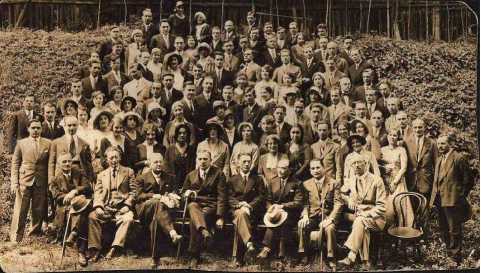 |
 |
A meeting of the Mathematics and Physics Society, Lvov, 1930
1. L. Chwistck, 2. S. Banach, 3. S. Loria, 4. K. Kuratowski,
5. S. Kaczmarz, 6. J. P. Schauder, 7. M. Stark, 8. K. Borsuk,
9. E. Marczewski, 10. S. Ulam, 11. A. Zawadzki, 12. E. Otto,
13. W. Zonn, 14. M. Puchalik, 15. K. Szpunar.
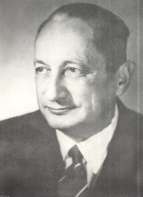 |
In 1932, the Polish Mathematical Society appointed Banach as
its Vice-President. His new responsibilities were quite
demanding, considering the institution's standing and
significance, but he accepted them without hesitation.
Especially important were its publications. The renowned
Polish mathematician Kazimierz Kuratowski (1896-1980), one of
the original founders of the Society, appraised them as
follows [10]:
,,The decision in 1931 to start publishing the
Mathematical Monographs should be considered a particularly
important event for Polish mathematics. It marked a new stage
in the development of the Polish School of Mathematics. The
earliest stage, which could be called the pioneering stage,
was characterized by the publication, almost always, of short
articles containing new results (appearing mainly in
Fundamenta Mathematicae and Studia Mathematica). A time came,
however, for a synthesis of all of the achievements of Polish
mathematicians, or even for a synthesis of all the
mathematics disciplines in which Poles had made especially
significant contributions. The initial plan was to publish
monographs on the subject of functional analysis: Volume I
Operations lineares (Theory of Linear Operations) by Banach,
Volume II Théorie de l'integrale (Theory of Integral) by
Saks, Volume III Topology by Kuratowski, Volume IV Continuum
hypothesis by Sierpiński and Volume V Theory of Trigonometric
Series by Steinhaus and Kaczmarz. In a very short time the
Mathematical Monographs achieved a position as one of the
most important scientific periodicals."
Banach also wrote textbooks of advanced mathematics that were
associated with and complemented his teaching programme.
Thus, volumes I and II of Differential and Integral Calculus
[11] appeared in 1929 and 1930, respectively, and volumes I
and II of Mechanics - In the Scope of Academic Studies [12]
were both published in 1938. These, as well as texts for use
in grammar schools, [7], co-authored with Stożek and
Sierpiński, were created during somewhat dramatic
circumstances for Banach.
Steinhaus wrote [6]:
,,He was always able to work under any conditions, and
in all circumstances, and was unaccustomed to ease and
comfort. His professor's salary of about 1000 zlotys per
month should have been quite adequate. However, his fondness
for frequenting coffee-houses, utter disregard of any
bourgeois concern for material interests, and an absence of
regularity in daily affairs, finally plunged him into debt
and very trying times. In an attempt to change his situation
he began writing textbooks."
Turowicz mentions [3] that Banach received help at that time
from Professor Benedykt Fuliński (1881-1942), who guaranteed
his debts to the creditors. At the same time Fuliński was
instrumental in getting Banach to change his spending habits
and set aside some of his income every month. However, it was
only his substantial income from his books that helped to pay
down the debts, which were only completely liquidated when
Banach received a prize from the Polish Academy of Arts and
Sciences. By this time it was already 1939.
In the meantime there was extensive world-wide interest by
mathematicians in Banach's work and results. At the 1936
International Congress of Mathematics in Oslo Banach was
entrusted with giving one of the keynote lectures on Die
Theorie der Operationen und ihre Bedeutung für die Analysis
(The Theory of Operations and its Significance in Analysis),
which was undoubtedly a sign of the high regard for and
interest in him personally and in his results.
In those days guests from all over the world visited Lvov:
from Austria - Moses Jacob;
from Czechoslovakia - Vaclaw Hlavaty;
from Denmark - Axel Andersen;
from France - Emil Borel, Maurice Fréchet, Henri Lebesgue,
Paul Montel;
from Germany - Leon Lichtenstein, Ernst Zermelo;
from Great Britain - A. Cyril Offord, A.J. Ward;
from Romania - Pierre Segrescu, Simion Stoilov;
from Switzerland Rolin Wavre;
from the USA - John von Neumann;
from the Soviet Union - Pavel S. Alexandrov, Nina Bari,
Nikolai N. Bogolyubov, Lazar A. Lusternik, Nikolai Luzin,
Dimitrii Menshov, S. Sobolev, and others.
In addition to the frequent visits of other Polish
mathematicians, e.g.,
from Warsaw - Karol Borsuk, Stefan Mazurkiewicz, Alfred
Tarski, Wacław Sierpiński;
from Vilnius - Antoni Zygmund.
Functional analysis was the main domain of Banach's
scientific work, and his results with it brought him world
fame, but he also made significant contributions in other
areas of mathematics. These included his work on the theory
of real functions, the theory of orthogonal series, and set
theory. One of the most spectacular results of set theory was
discovered jointly by Banach and Alfred Tarski (Teitelbaum)
(1902-1983) and was published in the paper "Sur la
décomposition des ensembles de parties respectivement
congruentes" (On Dissection of Sets of Points into Equal
Parts), in Volume VI of Fundamenta Mathematicae. In this
surprising paper, written in French in 1924, the authors
discovered that it is possible, by using very original
operations, to decompose a ball into parts and reassemble the
parts into two balls each identical to the original.
4 The Scottish Café
|
In this building the "Scottish Café" was
located, from a contemporary photograph. |
|
[Photographed by Nikodem Miranowicz] |
The Lvov School of Mathematics was renowned for its
coffee-house life, which had always been a favourite of
Banach's. In Lvov the meetings to discuss mathematics were
held in coffee-houses near the Mathematics Faculty, as in the
Scottish Café, on Fredro Street. Everyday sessions in
the Scottish Café, near the University, were very
often continuations of the meetings of the Lvov group of the
Polish Mathematical Society, and became an integral part of
the mathematicians' scientific work.
The students at the university did not normally frequent the
Scottish Café, and only two, Stanisław Ulam
(1909-1984) and his friend Józef Schreier (1909-1943), were
honored during their time as undergraduates to be invited to
participate in meetings there and to interact with such very
gifted mathematicians. Professor Andrzej Alexiewicz (1917-
1995) comments that to be invited to the Scottish Café
was tantamount to being knighted. Banach, Ulam and Stanisław
Mazur (1905-1981) formed the most intensive working team
there.
|
Stanisław Mazur and Stanisław Ulam |
One advantage of the Scottish Café was that it had
marble table tops on which one could easily write and,
perhaps more importantly, from which the writing could be
easily and quickly erased.
According to Hugo Steinhaus [6]:
,,One session lasted 17 hours and resulted in the
successful proof of an important postulate concerning Banach
spaces. No permanent record of it was made, however, and no
one since 9 has been able to reproduce it because it was
probably completely erased from the tabletop by the cleaners.
Unfortunately, many other proofs derived by Banach and his
students suffered the same fate.
The many hours spent in discussion of mathematics problems
resulted in an atmosphere of perseverance, excitement and
concentration and made it possible to forge intellectual
common ground."
Stanisław Ulam recalled [13]:
,,These long sessions in the cafes with Banach, or more
often with Banach and Mazur, were probably unique.
Collaboration was on a scale and with an intensity I have
never seen surpassed, equaled or approximated anywhere -
except perhaps at Los Alamos during the war years."
It would seem that for those who regularly took part in these
meetings and discussions at the Scottish Café, what
they were engaged in was not work but fun. It was in the end
a significant achievement, therefore, by Banach's wife Łucja
to have had the inspiration to buy a thick, hard covered
notebook that she presented either to the cashier or barman,
or perhaps to a cloak room attendant of the Scottish
Café with instructions to give it to any mathematician who
wanted to use it. Thus in the space of a few years there came
into existence the so-called, and now famous, Scottish
Book containing a collection of mathematics problems that
the Lvov mathematicians challenged each other with (and also
at the same time other world mathematicians), and which
included the solutions to some of the problems.
The list of Scottish Café guests who entered problems
in the Scottish Book was as follows. Stefan Banach was
an author or co-author of 25 problems. The others were:
Stanisław Ulam (62 problems), Stanisław Mazur (49), Władysław
Orlicz (14), Józef Schreier (10), Hugo Steinhaus (10), Herman
Auerbach (8), Juliusz Schauder (7), Samuel Eilenberg (6), Max
Eidelheit (5) Stanisław Ruziewicz (5), Mark Kac (4),
Władysław Nikliborc (4), Edward Szpilrajn (Edward Marczewski)
(4), Maurice Fréchet (2), Bronisław Knaster (2), Kazimierz
Kuratowski (2), Stanisław Saks (2), Ludwig Sternbach(2), A.J.
Ward (2), Pavel Alexandrov (1), 10 Nikolai N. Bogolyubov (1),
Karol Borsuk (1), Kampé de Fériet (1), A.F. Fermant (1),
Leopold Infeld (1), Stefan Kaczmarz (1), Lazar Lusternik (1),
Antoni Łomnicki (1), Józef Marcinkiewicz (1), John von
Neumann (1), A. Cyril Offord (1), Wacław Sierpiński (1),
Sergei Sobolev (1), Simion Stoilov (1), Rolin Wavre (1), and
Antoni Zygmund (1).
|
Formerly the Jan Kazimierz University, now the
Ivan Franko University. |
|
[Photographed by
Nikodem Miranowicz] |
|
Patriae decori civibus educandis (Educated
people adorn their country) - Sentencia in frontis almae
mater miae). |
|
[Photographed by Nikodem
Miranowicz] |
Anyone who entered a problem would offer a prize to the
person who came up with the solution. Different sorts of
prizes were offered: a bottle of wine (funded by Banach,
Mazur, Ulam, Sobolev), a bottle of whisky ("of non-zero
measure") (von Neumann), a bottle of brandy (Bogolyubov), a
bottle of champagne (Lusternik), a few small beers (Mazur,
Knaster), a small coffee (Steinhaus), 100 grams of caviar
(Steinhaus), 1 kilogram of bacon (Saks), a lunch in the
Dorothy restaurant in Cambridge (Ward) , a dinner in the best
hotel in Lvov: the George (Steinhaus), a "fondue" in Geneva
and "fondant" in Lvov (Wavre), and even a live goose
(Mazur).
|
Stanisław Mazur i Per Enflö |
|
[Photographed by Danuta Rago] |
The Scottish Book went through some tempestuous times
during the years after it came into existence. The Soviets
arrived in the city shortly after the outbreak of war and the
later entries in the book clearly indicate that it was Soviet
mathematicians who had made them. Following established
"protocol" they too promised prizes for solutions to the
problems they entered in it.
|
From the
left: Łucja Banach, Stefan Banach with son Stefan Jr.,
Marseilles (France), 1925. |
|
[This
photograph is from the private collection of the Banach
family and used here with the permission of Prof. Alina
Filipowicz-Banach.] |
|
Łucja
Banach with son Stefan Jr., Marseilles (France), 1925. |
|
[This photograph is from the private
collection of the Banach family and used here with the
permission of Prof. Alina Filipowicz-Banach.] |
Łucja Banach took the Scottish Book with her to
Wrocław after World War II. After her death in 1954 it passed
into the hands of son Stefan Banach Jr, a neurosurgeon, and
subsequent to his death into the possession of his close
family (his widow and two daughters) where it now resides.
Roman Kałuża wrote [2]:
,,For Polish mathematicians the Scottish Book
became an almost holy relic. Copies of it have been
circulated worldwide but the original is exhibited only
rarely. At the urging of Steinhaus a new notebook was
purchased in Wrocław and was named the New Scottish
Book. It was in use between 1946 and 1948 and fulfilled a
role similar to that of the original Scottish Book in
Lvov. It was in the care of Professors Marczewski and
Steinhaus. The tradition of the Scottish Book was thus
continued. However, the new version lacked the mythical and
legendary qualities that have characterized the original, the
unique and inimitable only one."
At Steinhaus' direction the Scottish Book was
transcribed in type. In 1957, Ulam had the book translated
into English and distributed copies of the translation among
mathematicians [15].
5 The Dark Years
At the time the Soviet army first occupied Lvov on 22
September 1939, the schools were all open and instruction was
in the Polish language. Banach was still a professor at Lvov
University and was also dean of the Mathematics and
Philosophy Faculty there. He was shortly later elected a
Corresponding Member of the Ukrainian Soviet Republic's
Academy of Sciences. Although always reluctant to get
involved in politics he accepted the nomination to be a
delegate member of the Lvov City Council. He also kept well
informed about and eagerly followed the work and significant
achievements of his former coworkers and students in the USA.
Years later Stefan Banach Jr recalled:
,,My father was invited to a conference in Kiev, two
days before the war broke out between Germany and the Soviet
Union. He went there and when he came back the war had
started. He had immediately taken the last train to Lvov and
arrived just before the Germans took over the city. I dared
to ask him in private why he did not stay (in Kiev). He
looked at me for a while and then he shrugged and told me
that he loved us and that was the way every Banach behaved."
German troops entered Lvov during the night of 30 June/1 July
1941, three days after the Soviets had fled the city. Its
inhabitants were still under the shock of the monstrous crime
perpetrated by the NKGB [People's Commissariat for State
Security - the Soviet secret police, intelligence and
counterintelligence service] on several thousand prisoners.
On 2 July, the Germans arrested Professor Kazimierz Bartel at
the Polytechnic.
During the night of 3/4 July, SS and Gestapo formations
arrested a group of 22 professors of the Jan Kazimierz
University, the Lvov Polytechnic and the Veterinary Academy.
They shot them all on the Wulka Hills near Lvov at dawn on 4
July [16]. During the time between 1939 and 1945 the Polish
School of Mathematics suffered very heavy losses. Many
mathematicians were murdered.
Among them were: Herman Auerbach (1901-1942); Kazimierz
Bartel (1882-1941); Max Eidelheit (1910-1943); Antoni
Hoborski (1879-1940); Stefan Kaczmarz (1895-1940); Stefan Jan
Kempisty (1892-1940); Michał Kerner (1902-1943); Mojżesz D.
Kirszbraun (1903 or 1904-1942); Stanisław Marian
Kołodziejczyk (1907-1939); Adolf Lindenbaum (1901-1942);
Antoni Łomnicki (1881-1941); Józef Marcinkiewicz (1910-1940);
Aleksander Rajchman (1890-1940); Stanisław Ruziewicz
(1889-1941); Stanisław Saks (1897-1942); Juliusz Paweł
Schauder (1899-1943); Józef Schreier (1908-1942); Włodzimierz
Stożek (1883-1941); and Zygmunt Zalcwasser (1898-1943).
Some died from natural causes and war privations: Leon
Chwistek (1884-1944); Samuel Dickstein (1851-1939); Stefan
Mazurkiewicz (1888-1945); Witold Wilkosz (1891-1941);
Stanisław Zaremba (1863-1942), and many others.
During the German occupation of Lvov (1941 to 1944) Banach,
together with numerous other academicians, various cultural
figures, some members of the resistance, as well as school
and university students, including his own son (a medical
student), was able to secure employment only at the Institute
for Typhus Studies. It operated under the direction of
Professor Rudolf Weigl and included experiments that required
the feeding of lice with human blood. It was a study of
importance and urgent interest to the German military and,
therefore, provided the participants with an invaluable
document that afforded them protection from persecution by
the occupiers.
At the outbreak of World War II the Biology Faculty at the
Jan Kazimierz University in Lvov, working in response to the
needs of the Polish Government's Ministry of the Army, was
producing large quantities of a vaccine against epidemic
typhus. It was for this reason that, following the Soviet
occupation of Lvov, on 22 November 1939, the Weigl Institute
was incorporated into the newly created Institute of
Bacteriology and Sanitary Science, and the Professor was
ordered to continue with the production of the vaccine.
Thereafter, with the exception of small quantities for
civilian use, the rest was being shipped to the Soviet Union
to protect the Red Army. In June 1941, the armed forces of
the Third Reich attacked the Soviet Union and entered Lvov.
The Institute, then called the Institute of Epidemiology and
Sanitary Science, was renamed Institut für Fleckfieber und
Virusforschung des OKH and, together with the Weigl
Institute, came under the control of the Germans. Profesor
Weigl was left in charge as Director of the Institute and
required to continue, and even to increase, the production of
the vaccine. A building on Potocki Street, at one time part
of the Queen Jadwiga Grammar School, and more recently used
by the Soviets, was provided for this end, and the entire
production of the vaccine was earmarked for use by the German
land armies.
As mentioned by Professor Stefan Kryński [17]:
,,It was the highly complicated situation the academic
staff found itself in July 1941, that motivated Weigl to
continue to run the Institute. He saw, thereby, an
opportunity to help the large 13 group of professors and
their assistants who had been left deprived of work and
position. He successfully extorted the Germans to allow him
to take full responsibility for and decide alone whom to
choose to be on his staff. The Institute thus grew quickly in
size. An unusual and unique group was formed to produce the
vaccine for epidemic typhus. It consisted of not just the
academics but also of the youth conspiring against the
occupiers and threatened with deportation to Germany, and
fighters in the underground resistance. Their only common
link with the Institute was the work permit they each
received."
|
Stefan
Banach at 52 years of age, Lvov 1944 |
|
[This
photograph is from the private collection of the Banach
family and used here with the permission of Prof. Alina
Filipowicz-Banach.] |
Banach's work at the Institute lasted until the end of the
Nazi occupation of Lvov, that is, until July 1944. He was
shortly thereafter offered the Chair of Mathematics at the
Jagiellonian University in Krakow, but his serious illness,
and ultimate death, prevented him from assuming the position.
Many years later Stefan Banach Jr related:
,,During that time my father came and visited me in
Krakow in 1944. He spent a couple of days there and looked
better (...). He told me that he was "switching" to study
physics problems and had some ideas that should win him the
Nobel Prize. Our parting was sad and tinged with a sense of
hopelessness. Reality dealt us a blow worse than we could
have imagined because that was the last time I saw him."
Władysław Nikliborc (1889-1948) took selfless and very
attentive care of the gravely ill Banach during the last few
months of his life.
Stefan Banach Jr recalled:
,,For several months Nikliborc nursed my father and my
grieving mother and was a guardian and messenger boy for
them. I do not know how within this little person there could
be so much heart and courage."
|
[This photograph is from
the private collection of the Banach family and used here
with the permission of Prof. Alina Filipowicz-Banach.] |
Stefan Banach died from lung cancer on 31 August 1945. He
died in Lvov, at the house where he had been staying with his
friends, the Riedl family, and was interred in their family
sepulcher in the Łyczaków Cemetery in Lvov, next to the tomb
of Maria Konopnicka.
|
The house of the Riedl family, where Stefan Banach died. |
|
[This photograph is from the private
collection of the Riedl family and used here with the
permission of Prof. Tadeusz Riedl.] |
Stefan Banach died before his time at the young age of 53
when still full of plans and ideas, and with a very promising
future ahead of him.
|
[This photograph is from the private
collection of the Riedl family and used here with the
permission of Prof. Tadeusz Riedl.] |
6 Epilogue
Functional analysis which Banach created continued to spread
to countless mathematics centers throughout the world. His
ideas and discoveries have been bearing fruit and radiating
to all the continents. The designation Polish School of
Mathematics, of which he was the pillar, architect and
founder, has become a symbol of excellence.
The name of Stefan Banach has already been cited 12,000 times
in mathematics publications worldwide. As of December 2006,
the Google Internet search engine has indexed more than one
million pages in which the term Banach space appears (in
various languages). The term Banach algebras appears
approximately 200,000 times, and the Hahn-Banach theorem
100,000 times.
In 1946, the Polish Mathematical Society established the
Stefan Banach Award, and the Polish Academy of Sciences has
conferred a special Stefan Banach medal since 1992. Many
schools and streets have been, and continue to be, named
after him, and in 1972 the International Stefan Banach
Mathematical Center was established. In 1999 in Krakow, a
statue of Stefan Banach was unveiled on the 54th anniversary
of his death.
|
Medal of the Polish Academy of Sciences to
commemorate the hundredth anniversary of the birth of Stefan
Banach. |
|
Bust of Stefan Banach in the Stefan Banach
International Mathematical Center in Warsaw. |
|
[Photographed by Nikodem Miranowicz] |
|
Statue of Stefan Banach in front of the
Mathematics and Physics Institute of the Jagiellonian
University in Krakow. |
Relief of Stefan Banach and stained glass
(Dariusz Jasiewicz's works) at the Stefan Banach High
School
(Zespół Szkół Technicznych i Ogólnokształc±cych) in
Jarosław. |
|
[Photographed by Adam
Tomaszewski] |
|
Medal and diploma h.c. of the University of the
Andes (Venezuela) for Stefan Banacha. |
|
Postage stamps with the images Polish
mathematicians: Zygmunt Janiszewski, Stefan Banach, Stanisław
Zaremba and Wacław Sierpiński |
|
[from the
collection of Władysław Alexiewicz] |
|
Poster to
commemorate the hundredth anniversary of the birth of Stefan
Banach. |
Mark Kac (1914-1984), who considered Banach "probably the
greatest Polish mathematician of all times" [18], wrote
[19]:
,,Banach was the unquestioned superstar of Polish
mathematics and his name is known wherever mathematics is
taught. In the short fifty-three years of his life (...) he
succeeded in combining an overwhelming flow of brilliant
ideas with a style of high living that few men could
sustain."
Steinhaus finished his address at the Stefan Banach memorial
conference with the words [6]:
,,Banach gave to Polish science, and particularly to
Polish mathematics, more than anyone else. (...) He combined
within himself a spark of genius with an astonishing internal
urge, which addressed him incessantly in the words of the
poet: "there is only one thing: the ardent glory of one's
craft" ["Il n'y a que la gloire ardente du métier"
(Verlaine)] - and mathematicians well know that their craft
consists of the same secret as the poets' craft."
References
[1] Marian Albiński, "Wspomnienia o Banachu i Wilkoszu"
(Reminiscences of Banach and Wilkosz), Wiadomo¶ci
Matematyczne 19, 133-135 (1976).
[2] Roman Kałuża, Through a Reporter's Eyes: The Life of
Stefan Banach (Birkäuser, Boston, 1996, 2005) and, in
Japanese, Banacha to Porando Sugaku (Banach and Polish
mathematics) (Springer Mathematics Club). These are
translations from Polish of Stefan Banach (GZ Publ., Warsaw,
1992).
[3] Andrzej Turowicz, Reminiscences recorded on a tape (in
Polish), Tyniec, April 27th, 1989.
[4] Zbysław Popławski, Dzieje Politechniki Lwowskiej
1844-1945 (History of Lvov Polytechnic 1844-1945)
(Wrocław-Warsaw-Krakow, Ossolineum, 1992); Politechnika
Lwowska 1844- 1945 (Lvov Polytechnic 1844-1945), ed. R.
Szewalski et al. (Wrocław, Wrocław Polytechnic Publ., 1993).
[5] Tadeusz Riedl, Chodz±c po Lwowie (Strolling in Lvov)
(Bernardinum Publ., Pelplin, 2006).
[6] Hugo Steinhaus, "Stefan Banach. Przemówienie wygłoszone
na uroczysto¶ci ku uczczeniu pamięci Stefana Banacha",
(Stefan Banach. An Address Delivered at the Stefan Banach
Memorial Conference), Wiadomo¶ci Matematyczne 4, 251-259
(1961).
[7] Krystyna Wuczyńska, "O podręcznikach szkolnych Stefana
Banacha", (About the School Textbooks Written by Stefan
Banach), Matematyka 45, 96-100 (1992).
[8] Krzysztof Ciesielski, Zdzisław Pogoda, "Mathematical
Diamonds", Prószyński i S-ka, Warszawa, 1997.
[9] Stefan Banach, Théorie des opérations linéaires,
Monografie Matematyczne (Mathematical Monographs) vol. 1
(Fundusz Kultury Narodowej, Warszawa, 1932). This is in an
extended version of the Polish edition of Teorja operacyj.
Tom 1. Operacje linjowe (Theory of Operations. Vol. 1: Linear
Operations) (Kasa im. Mianowskiego, Warszawa, 1931). Other
reprints in French: Hafner Publ., New York, 1932, 1948;
Chelsea Publ., New York, 1932, 1955, 1963, 1978, 1988, 1999;
Jacques Gabay, Sceaux (France), 1993; also reprinted in
Banach Oeuvres. English trans.: Theory of Linear Operations
(North-Holland, Amsterdam-New York-Oxford-Tokyo, 1987).
Russian trans.: Theory of Linear Operations (R
C Dynamics,
Izhevsk 2001, 3rd ed.). Ukrainian trans.: A Course in
Functional Analysis (Radianska Shkola, Kiev, 1948).
[10] Kazimierz Kuratowski, A Half Century of Polish
Mathematics: Remembrances and Reflections (Pergamon Press,
Oxford and Polish Scientific Publ. PWN, Warsaw, 1980). This
is a translation from Polish of Pół wieku matematyki
polskiej 1920-1970 (Wiedza Powszechna, Warsaw, 1973).
[11] Stefan Banach, Rachunek różniczkowy i całkowy
(Differential and Integral Calculus), vol. 1 (Zakład Narodowy
im. Ossolińskich, Lvov 1929), vol. 2 (Ksi±żnica-Atlas, Lvov,
1930). Russian trans.: Differential and Integral Calculus
(Fizmatgiz 1958; Nauka, Moscow, 1966, 1972, 1986). Hungarian
trans.: Differenciál és Integrálszámítás (Tankönyvkiadó,
Budapest 1967, 1969, 1971, 1975).
[12] Stefan Banach, Mechanics, Monografie Matematyczne
(Mathematical Monographs) vol. 24 (Warszawa-Wrocław, 1951).
This a translation from Polish of Mechanika w zakresie szkół
akademickich (Mechanics - In the Scope of Academic Studies),
part 1 - Monografie Matematyczne vol. 8, part 2 - Monografie
Matematyczne vol. 9 (Warsaw-Lvov-Wilno 1938).
[13] Stanisław Ulam, Adventures of a Mathematician (USP,
Berkeley, USA, 1976, 1991).
[14] Edward Marczewski, "Pocz±tki matematyki wrocławskiej"
(The Beginnings of the Wroclaw School of Mathematics),
Wiadomo¶ci Matematyczne, 12, 63-76 (1969).
[15] Stanisław Ulam, The Scottish Book: a Collection of
Problems (Los Alamos, 1957).
[16] Zygmunt Albert, KaĽń profesorów lwowskich - lipiec 1941
(Massacre of the Lvov Professors - July, 1941) (Wrocław
University Publ., Wrocław, 1989).
[17] Stefan Kryński, "Rudolf Weigl (1883-1957)", e-print at
http://lwow.eu/weigl/czlowiek.html
[18] Mitchell Feigenbaum, "Reflections of the Polish
Masters: An Interview with Stan Ulam and Mark Kac", Los
Alamos Science 3, No. 3, 54-65 (1982).
[19] Mark Kac, Enigmas of Chance. An Autobiography (Harper |
Row, New York, 1985).
|
Family mementoes of Stefan Banach at the home of Alina
Filipowicz-Banach. |
Acknowledgements
We deeply thank Prof. dr. hab. med. Alina
Filipowicz-Banach and the whole of family of Stefan Banach
for their permission to post all the works and photographs of
Stefan Banach on this website. We also thank Dr. John J.
Greczek for this English translation.
Emilia Jakimowicz and Adam Miranowicz
|
[Photographed by Adam Miranowicz] |
|
Stefan
Banach Jr. with his wife, Alina Filipowicz-Banach, and their
younger daughter Kasia. |
|
Stefan
Banach Jr. and Alina Filipowicz-Banach |
|
Stefan
Banach Jr. and Alina Filipowicz-Banach |
|
Iwona
Banach-Suchowierska - older daughter of Stefan Banach Jr. and
granddaughter of Stefan Banach |
|
Joachim
Stefan Suchowierski - son of Iwa Banach-Suchowierska,
great-grandson of Stefan Banach. |
|
Kasia
Banach - younger daughter of Stefan Banach Jr. with her
daughters. |
|
Georgia
and Audrey Salas - daughters of Kasa Banach, granddaughter of
Stefan Banach |
|
[These photographs are from
the private collection of the Banach family and used here
with the permission of Prof. Alina Filipowicz-Banach.] |
File translated from
TEX
by
TTHgold,
version 4.00.
On 23 Jan 2012, 15:47.
| 









